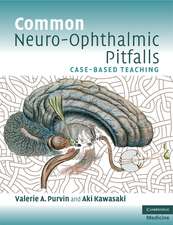Catecholamines and Behavior · 2: Neuropsychopharmacology
Autor Arnold J. Friedhoffen Limba Engleză Paperback – 6 apr 2012
Preț: 365.25 lei
Preț vechi: 384.48 lei
-5% Nou
Puncte Express: 548
Preț estimativ în valută:
69.91€ • 72.70$ • 58.50£
69.91€ • 72.70$ • 58.50£
Carte tipărită la comandă
Livrare economică 14-28 martie
Preluare comenzi: 021 569.72.76
Specificații
ISBN-13: 9781468431407
ISBN-10: 1468431404
Pagini: 244
Ilustrații: XIII, 225 p. 2 illus.
Dimensiuni: 152 x 229 x 13 mm
Greutate: 0.33 kg
Ediția:Softcover reprint of the original 1st ed. 1975
Editura: Springer Us
Colecția Springer
Locul publicării:New York, NY, United States
ISBN-10: 1468431404
Pagini: 244
Ilustrații: XIII, 225 p. 2 illus.
Dimensiuni: 152 x 229 x 13 mm
Greutate: 0.33 kg
Ediția:Softcover reprint of the original 1st ed. 1975
Editura: Springer Us
Colecția Springer
Locul publicării:New York, NY, United States
Public țintă
ResearchCuprins
1 The Role of Catecholamines in Animal Learning and Memory.- 1. Definitions.- 2. Problems of Specificity.- 3. Experimental Approaches 6.- 4. CA as Independent Variable 6.- 5. Behavior as Independent Variable 19.- 6. Conclusions.- 7. References.- 2 Stress and Catecholamines.- 1. Introduction.- 2. Tissue Levels of Norepinephrine and Dopamine.- 3. Turnover.- 4. Metabolites.- 5. Functional Significance.- 6. References.- 3 The Catecholamines: Possible Role in Affect, Mood, and Emotional Behavior in Man and Animals.- 1. Introduction.- 2. Catecholamines and Affect: Historical Perspectives.- 3. Catecholamines and Affect: Methodologic Issues in Human and Animal Studies.- 4. Affect-Related Behavior Resulting from the Administration of Catecholamines and Catecholamine-Altering Drugs.- 5. Alterations in Catecholamine Metabolism Resulting from Affect-Related Behavior.- 6. Interrelationships between Affects and Psychomotor Activation: A Reevaluation of the Role of Catecholamines in Affect-Related Behavior.- 7. Summary.- 8. References.- 4 Catecholamines and Depression: A Further Specification of the Catecholamine Hypothesis of the Affective Disorders.- 1. Introduction.- 2. Metabolism of Norepinephrine.- 3. MHPG in Affective States.- 4. Subgroups of Depression.- 5. Biochemical Mechanisms in Affective Disorders.- 6. Summary.- 7. References.- 5 Catecholamines and Psychosis.- 1. Introduction.- 2. Dopamine Theory of Schizophrenia.- 3. Amphetamine Psychosis as a Model.- 4. Mechanism of Amphetamine Psychosis.- 5. Transmitter Balance.- 6. Two-Factor Theory of Schizophrenia.- 7. References.- 6 Serum Dopamine-?-Hydroxylase in Various Pathological States.- 1. Introduction.- 2. Determination of D?H Activity in Human Serum.- 3. Determination of Immunoreactive (IR) D?H Levels in Human Serum.- 4.Serum D?H Levels: Enzymatic Assay Versus Radioimmunoassay.- 5. Serum D?H Activity in Neuroblastoma.- 6. Serum D?H Activity in Familial Dysautonomia.- 7. Serum D?H Levels in Down’s Syndrome.- 8. Serum D?H Activity in Affective States.- 9. Discussion and Conclusions.- 10. References.- 7 Possible Roles of Catecholamines in the Action of Narcotic Drugs.- 1. Introduction.- 2. Effects of Other Drugs on Opiate Activity.- 3. Opiate-Induced Alterations in the Levels of Brain Catecholamines.- 4. Opiate-Induced Alterations in the Turnover of Brain Catecholamines.- 5. Effects of Opiates on the Transport of Catecholamines.- 6. Effects of Opiates on the Adenyl Cyclase System in Brain.- 7. Dopamine Receptor Hypothesis.- 8. Discussion and Conclusions.- 9. References.- 8 Metabolic Adaptation to Antidepressant Drugs: Implications for Pathophysiology and Treatment in Psychiatry.- 1. Biochemical Indices of Psychotropic Drug Action.- 2. Adaptive Mechanisms in Central Synapses.- 3. Enzymatic Adaptation to Chronic Drug Administration.- 4. A Model for Neurochemical Adaptation to Tricyclic Drugs.- 5. A Revised Theory of Depressive Illness.- 6. References.- 9 Integration and Conclusions.- 1. Introduction.- 2. Research Strategies.- 3. Determinants of Behavior.- 4. Conceptual Models for the Multiple Roles of Catecholamines in Brain.- 5. New Conceptual Models of Psychopathological States.- 6. Development of New Treatments.- 7. Directions for Future Research.














